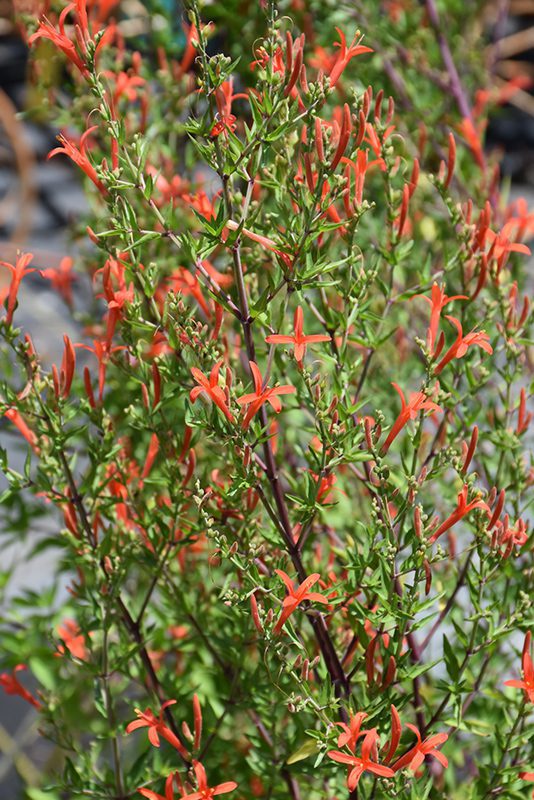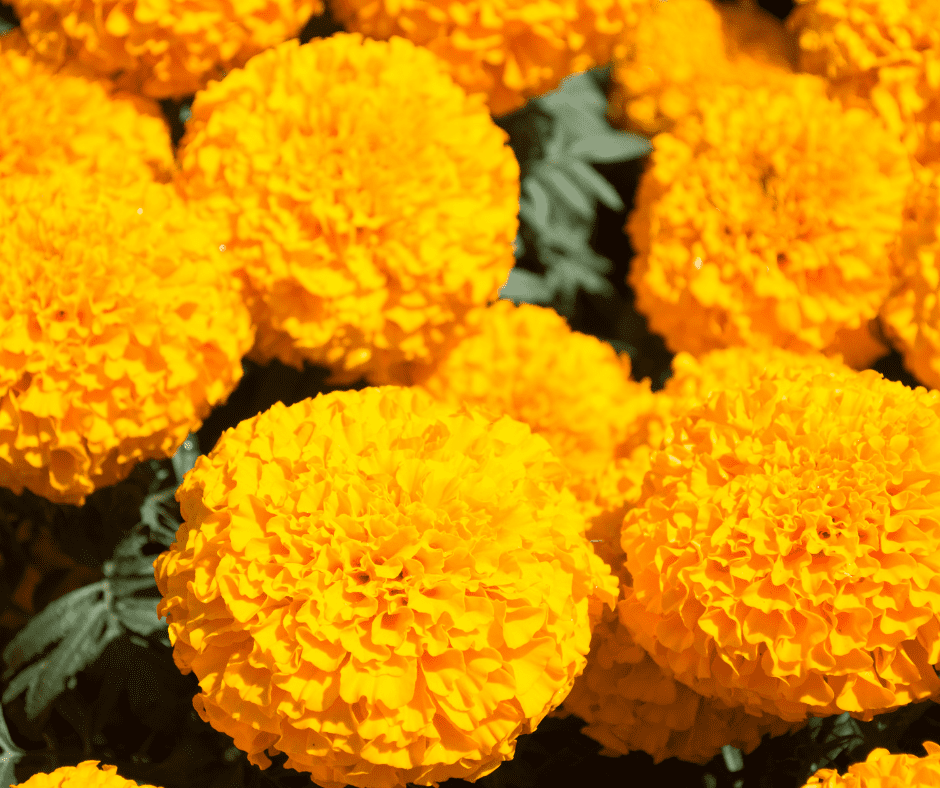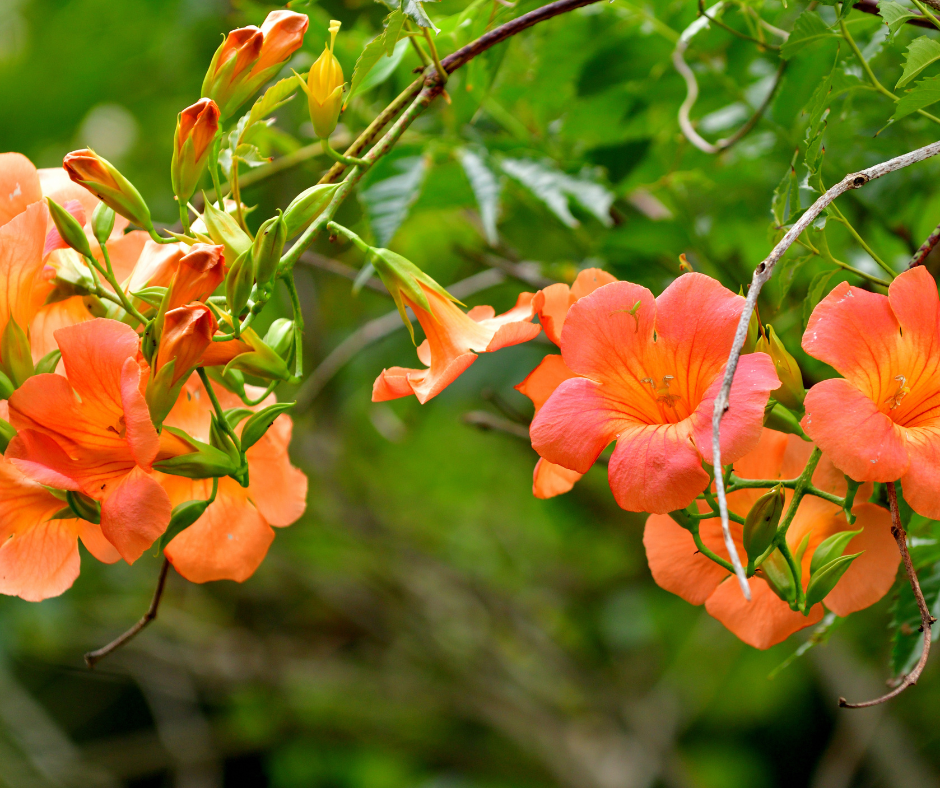Fall’s reigning color, the hue of a dipping sunset and fresh-squeezed juice in the morning, today’s “Plant a Rainbow Garden” edition celebrates the color orange. Let’s welcome (or coerce) the cooler fall temperatures with some vibrant bloomers that will see you into winter. We’re looking at you, Flame Acanthus, Fall Mari-Mums and Orange Trumpet Vine.

Flame Acanthus
The Flame Acanthus thrives in San Antonio gardens as a vibrant beacon of color and life. This perennial beauty, also known as Anisacanthus quadrifidus var. wrightii, offers nectar-filled, fiery, orange-red blooms to our local pollinators. Hummingbirds are especially enamored with the tubular flowers which appear in profusion summer through fall. Flame Acanthus is also a host plant to the Crimson Patch butterfly.
The Flame Acanthus is not just a visual delight; the plant’s resilience makes it ideally suited to the San Antonio climate. Once established, this Texas native is wonderfully drought-tolerant, capable of withstanding the region’s harsh sun and dry spells with ease. It has no real known issues with pest or disease and reliably returns year after year with minimal fuss. Something to be mindful of is that it reseeds itself pretty readily. It has the tendency to pop up in other areas in your landscape. You can pull up volunteers fairly easily. Average mature growth in our area is 3-5′ T x 3-4′ W.
Flame Acanthus prefers full sun to part shade and thrives in well-drained soil. It is not particularly fussy about soil type, as long as it doesn’t end up in an area with standing water. While its watering needs are low, like most plants, it will still benefit from occasional watering during prolonged periods of heat and drought. A light application of balanced fertilizer in early spring can encourage robust growth and flowering, although the plant is quite self-sufficient. The majority of its maintenance consists of a few easy cut backs (1/3 of the plant) throughout the year so that it doesn’t flop over from the center. Flame Acanthus responds to and recovers from pruning very well. With its low maintenance needs and stunning display of fiery orange color, the Flame Acanthus is a cherished addition to any sun to part shade Texas garden.

Orange Fall Mari-Mum
For those of you who love an update to your annual color beds, these next pops of orange can make a big statement in your fall gardens. Fall Mari-Mums are cheerful orange (or yellow) annuals that delight both gardeners and pollinators with their large pom-pom flowers. The term “Mari-Mum” is actually a concept of using large blooming marigolds in the fall garden as opposed to the traditional use of chrysanthemums. Chrysanthemum + Marigold = Mari-Mum. Stay with me here.
While marigolds planted in springtime can struggle with spidermite issues once the heat of summer starts to arrive, marigolds planted in fall avoid the issue altogether. Marigold blooms last 2- 3 weeks longer than traditional chrysanthemums and they are inexpensive at the nurseries. For fall planting, it’s important to try to find transplants that don’t currently have blooms; choose those with only vegetation or buds to transplant now for the best results. The reason being is that full-blooming mari-mums will have all their energy pushed into their flowers as opposed to being directed to their roots that need to get established. You’re welcome.
Look for the variety “Antiqua Orange” (again, also available in yellow), for a big punch of juicy fall color. Planted in mass, these flowers can make a big, bold, orange statement. Butterflies love the large, flat-topped, open shape of mari-mums as they offer a great source of late season nectar to provide energy for all of our local pollinators. These flowers grow to an average mature form of 8-10 inches tall; when planting, space these the same distance. Mari-Mums need full sunshine to thrive, along with well-draining soil. Take care not to overwater them in the cooler temperatures of fall. Plant mari-mums deep, like how you are advised to plant tomatoes, up to the first or second of leaves. This will provide even more support for the heavier blooms by allowing for more adventitious roots to grow off the stems. Get ready to enjoy these orangey delights to first frost.

Orange Trumpet Vine
Growing Orange Trumpet Vine (Campsis radicans) in San Antonio, Texas, can be a delightful experience, adding vibrant color and life to your garden. This hardy vine is renowned for its rapid growth, reaching lengths of up to 30 feet at maturity. Providing sturdy support, such as trellises, fences, or arbors, to train the vine properly is essential. This will not only help the plant grow healthily but also enhance the appeal of your garden space.
The flowers of trumpet creeper vine are breathtakingly beautiful, with their bright orange, trumpet-shaped blooms creating a stunning display. These flowers typically appear from late spring through summer and sometimes into fall, offering a long-lasting burst of color in your garden. In San Antonio’s warm climate, you can expect the showy blooms to attract a variety of pollinators, including hummingbirds and butterflies, making your garden lively and motion-filled with these delightful creatures.
Orange trumpet creeper thrives in full sun, which is abundant in San Antonio, but it can also tolerate partial shade. For optimal growth, plant it in well-drained soil enriched with organic matter and use a balanced fertilizer during the growing season to promote lush foliage and prolific blooms.
Orange trumpet creeper can withstand temperatures as low as 10 degrees Fahrenheit. However, in the rare case of an exceptionally harsh winter in San Antonio, the vine may die back to the ground. If this occurs, don’t worry—simply prune the dead wood in early spring, and the vine will likely regenerate with vigor. Its resilience makes it a reliable choice for gardeners in the area. By providing the right conditions and care, you can enjoy the vibrant orange blooms and lively pollinators that this striking vine brings to your garden year after year.
Make plans to join us right here next week when we celebrate the dazzling hue of red! Plant a rainbow garden and live your life in technicolor!
~The Happy Gardener, Lisa Mulroy

